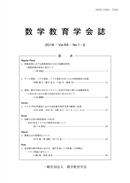Volume 44, Issue 1-2
Japan Journal of Mathematics Education and Related Fields
Displaying 1-13 of 13 articles from this issue
- |<
- <
- 1
- >
- >|
-
2003Volume 44Issue 1-2 Pages 1-4
Published: 2003
Released on J-STAGE: May 30, 2020
Download PDF (515K) -
2003Volume 44Issue 1-2 Pages 5-6
Published: 2003
Released on J-STAGE: May 30, 2020
Download PDF (240K) -
2003Volume 44Issue 1-2 Pages 7-17
Published: 2003
Released on J-STAGE: May 30, 2020
Download PDF (1085K) -
2003Volume 44Issue 1-2 Pages 19-32
Published: 2003
Released on J-STAGE: May 30, 2020
Download PDF (6693K) -
2003Volume 44Issue 1-2 Pages 33-50
Published: 2003
Released on J-STAGE: May 30, 2020
Download PDF (2079K) -
2003Volume 44Issue 1-2 Pages 51-60
Published: 2003
Released on J-STAGE: May 30, 2020
Download PDF (1156K) -
2003Volume 44Issue 1-2 Pages 61-71
Published: 2003
Released on J-STAGE: May 30, 2020
Download PDF (1624K) -
2003Volume 44Issue 1-2 Pages 72-
Published: 2003
Released on J-STAGE: May 30, 2020
Download PDF (145K) -
2003Volume 44Issue 1-2 Pages 73-82
Published: 2003
Released on J-STAGE: May 30, 2020
Download PDF (1077K) -
2003Volume 44Issue 1-2 Pages 83-91
Published: 2003
Released on J-STAGE: May 30, 2020
Download PDF (1468K) -
2003Volume 44Issue 1-2 Pages 93-100
Published: 2003
Released on J-STAGE: May 30, 2020
Download PDF (1277K) -
2003Volume 44Issue 1-2 Pages 101-
Published: 2003
Released on J-STAGE: May 30, 2020
Download PDF (105K) -
2003Volume 44Issue 1-2 Pages 102-106
Published: 2003
Released on J-STAGE: May 30, 2020
Download PDF (936K)
- |<
- <
- 1
- >
- >|
